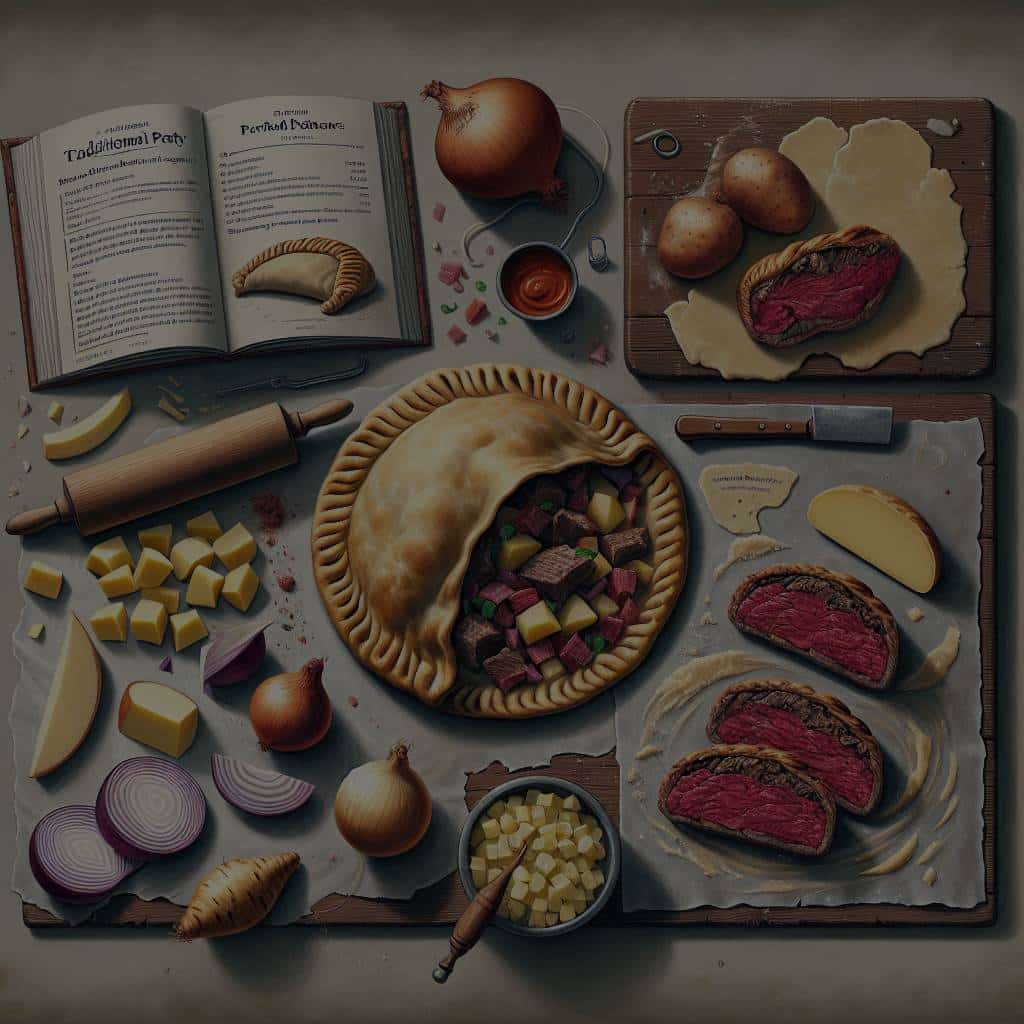What’s the Best Way to Cook a Traditional Cornish Pasty with Meat and Potatoes?

For a taste of the English Southwest, there is no dish quite as emblematic as the traditional Cornish pasty. This delicious pastry parcel is a wholesome blend of meat, potatoes, and a touch of butter, wrapped in a crispy pastry dough. It’s not only a classic British comfort food, but it also holds a revered place in the culinary history of Cornwall.
The History of the Cornish Pasty
Before diving into the Cornish pasty recipe, let’s take a moment to appreciate its historical roots. The Cornish pasty originated from Cornwall, a region in the southwest of England known for its mining industry in the 17th and 18th centuries. Miners found these pasties easy to carry, and their robust casing was ideal for surviving the harsh conditions of the mine.
Dans le meme genre : What’s the Secret to a Fluffy and Flavorful Japanese Soufflé Pancake?
The Cornish pasty was traditionally filled with beef, potatoes, and a few other ingredients such as turnip and onion. It was then seasoned with salt and pepper. The ingredients were all enclosed in a pastry dough, which was crimped to create a seal, thus preserving the filling.
The Perfect Dough for the Cornish Pasty
To create an authentic Cornish pasty, it all starts with the pastry dough. It should be firm yet flaky, robust enough to hold the filling, but also tender and delicious in its own right. Here’s how you can achieve it.
A découvrir également : How to Create a Luxe Caviar Tasting Experience at Home with Traditional Accompaniments?
- Ingredients:
- 500g plain flour
- 120g lard
- 75g butter
- Pinch of salt
- 175ml cold water
Start by sifting the flour and salt into a large mixing bowl. Cut the lard and butter into small cubes, then add them to the flour mixture. Rub the fat into the flour with your fingertips until it resembles breadcrumbs. Gradually add the water, stirring until the mixture comes together into a dough. Knead the dough lightly for a few minutes, then cover and let it rest for 30 minutes.
The Essential Pasty Filling
The heart of a Cornish pasty is its hearty filling. The traditional ingredients are beef steak, potatoes, and a pinch of salt. But the beauty of a pasty is its versatility — you can add other ingredients to suit your taste.
- Ingredients:
- 400g beef skirt or chuck steak
- 200g potatoes
- 100g onion
- Salt and pepper to taste
- 1 egg (for glazing)
Cut the beef into small, bite-sized pieces. Peel the potatoes and cut them into similar sized pieces. Dice the onion. Mix all the ingredients together in a bowl, seasoning generously with salt and pepper.
Assembling and Baking the Cornish Pasties
Once your dough and filling are ready, it’s time to assemble your pasties. Divide the dough into four equal parts. Roll each part into a circle about 1/4 inch thick. Add a quarter of the filling to one half of each circle, leaving a border around the edge. Fold the empty half of the dough over the filling, then crimp the edges to seal.
Preheat your oven to 200°C (392°F). Place the pasties on a baking sheet, then brush each one with beaten egg to give it a golden color. Bake for 45-50 minutes, until the pasties are golden brown and the filling is cooked.
Enjoying Your Cornish Pasty
The best way to enjoy a Cornish pasty is fresh out of the oven. The crisp pastry, the tender beef, and the perfectly cooked potatoes make for an irresistible combination. However, you can also let them cool and enjoy them at room temperature, or even reheat them later. They make a great lunch or dinner, and can easily be transported for a picnic or a work lunch.
So there you have it – the method to making an authentic and delicious Cornish pasty. It may require a bit of time and effort, but the result is well worth it. Enjoy the process and the satisfaction of creating this traditional dish from scratch.
The Secrets of a Successful Cornish Pasty
Understanding the intricacies of each element, from the pastry dough to the filling, is crucial in making a perfect Cornish pasty.
Firstly, always use cold butter and lard for your dough. This ensures that the fat is evenly distributed throughout the dough, which in turn helps to achieve that delicate, flaky texture. When mixing the dough, don’t overwork it. A light touch guarantees a tender, crumbly crust.
As for the filling, using beef skirt or chuck steak is recommended. These cuts have good marbling which renders down during baking, providing rich flavour and tender texture. When cutting the beef and potatoes, aim for uniform sizes to ensure that they cook evenly.
Additionally, seasoning is vital. Don’t skimp on the salt and pepper – they provide a critical flavour base that enhances the taste of the beef and potatoes.
While a food processor can expedite the dough-making process, remember that the best Cornish pasties are often made by hand. There’s something about the human touch that imparts a distinct character to the pasty.
Crimping is another essential aspect. This traditional method not only seals the pasty but also provides a convenient handle for eating. This was particularly useful for the miners who didn’t want to ingest the residue from their hands.
Lastly, don’t forget the egg wash. This is what gives the pasty that beautiful golden hue. Simply beat an egg and brush it over the pasty before baking.
Conclusion: Savoring the Flavor of Tradition
Steeped in rich history and tradition, the Cornish pasty is a culinary representation of Cornwall’s past. Every bite of this flavorful pastry is a nod to the hard-working miners who once depended on it for sustenance.
From the tender chunks of beef skirt and potatoes encased within a shortcrust pastry, to the subtle kick of salt and pepper, the Cornish pasty is a testament to the beauty of simplicity in cooking. It’s not overly complicated or flashy, but it’s this humble character that makes it so comforting and satisfying.
Whether you’re grabbing one for lunch, serving it for dinner, or packing it for a picnic, the Cornish pasty is versatile and always delicious. The process of making it from scratch can be quite therapeutic, and the result is a wonderfully flaky pasty filled with tender, succulent filling.
So why not try your hand at this pasty recipe? Relegate the pre-made pie crusts to the back of the cupboard and sink your teeth into a homemade Cornish pasty. It’s a culinary journey that takes you to the heart of Cornwall, without leaving your kitchen.
In the end, the best way to cook a traditional Cornish pasty is with love and patience, respecting the ingredients and the process. Just like the miners of Cornwall, take pride in your creation and savor every bite. As you enjoy your pasty, fresh from the oven and golden from the egg wash, remember that you’re partaking in a tradition that goes back centuries. Quite simply, there’s no other food quite like the Cornish pasty.
